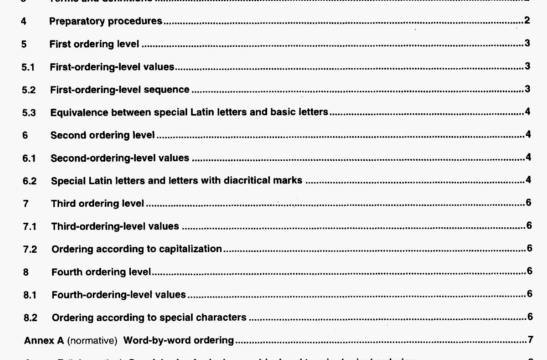ISO 12199 pdf download – Alphabetical ordering of multilingualterminological and lexicographical data represented in the Latin alphabet.
A.2 MultIplekey ordering
Single-key ofdwiing te descrt*d in the main body of this Inlernabonal Standard. In mullsple.key orderrtg. Millie ordering rules ate applied to one key before they are applied to the next. until all the keys have been considered or a unaque sequence has been estab’ished
NOTE One typal ciampte of nxle4iey ordeiwig 4 a bet of delegates to a meeting, where the lil key may be the country iiies, the second key may be the delegates’ last iiemes. and the Paid key may be the delegates’ timI names. In ttile example. d a coiawIy has one delegate only, the second key (last names) will not be oiwideied
A.3 Word-by-word ordering as multiple-key ordering
In wd yword ordenrg. space characters, and posd#y also by de1m4n other dxaracters, are key separators. l’h. keyseparaScw characters function as key separators only, and they have no position in th. ordering sequence.
When the character stnng has been divided into a sequence of keys, the ordenng rules of the main body of this Inhematiortal Standard are invoked for one key at a time.
NOTE I In ddeion to the space characters. some or ii punctuation made may be debed key separators. N may ao be useful to define some space characters as key separators, whle other epace characters reman epaail characters wefim a key. The choices we depend on Ianguag.(st and type of strings to be ordered.
NOTE 2 II space characters and hyphens are defined as key separators, the title ci this clause would be spil ‘o lb. follosrng keys ‘cA.3 Word, .cby cwOd> cordeompi. as cmu(W key> rotdeflnp>. wher, each key I. ooritaWied within
There are no universaly accepted ordering rulee tot chemical names. The ordering rules of the main body of this Intemahonal Standard may be used, If so desired with the extension of the word-byword ordenng rules dsaibed in annex A.
However. some indexes and databases, in particular at the Chemical Abetracts Services (CAS), use a specialty designed mutliple.key ordering systerft The main features of this system are outlined befow.2)
C.2 Dtvis)on into three key.
C.2.1 Parent name
The first key consists of the parent name. which normaly wrn be ii roman letters and space characters. whether or not interrupted by Italic letters. Greek leders, gfs or special characters (e.g punctuation).
C2.2 biltial locants
The second key consists of initial locarils. being all characters before the first roman letter.
C.2.3 Other locants
The third key consists of a non-inthal locants, being all r.mrng characters.
NOTE The nam 2.Aanone-1.1.1.4 3.3-deiiethyr ir ded rile three keys se lobes: ‘cButanon. dineisib ‘c2.. c-I.f.l4 3.3.,.
C.3 Ord.rlng rules within each key
Th. first key e ordered accorng to the rules of the meN body of this bitemabonal Standard. In the second and third keys, the following order 1 uSad:
— letters of the Latin alphabet (which e bern iac), in the order specified in 5.2. Item b):
— letter of the Greek alphabet, in the order ven Wi 5.2. hem C):
— numerals. in the order of the numeric value.
C.4 Output
Table C.1 shows ordered output from the rules that are descrted in this annex compared with output from the rule. of the main body of this International Standard.
ISO 12199 pdf download – Alphabetical ordering of multilingualterminological and lexicographical data represented in the Latin alphabet
